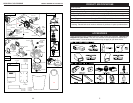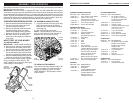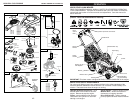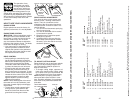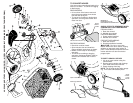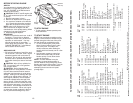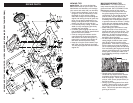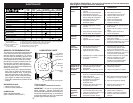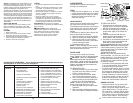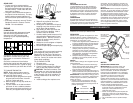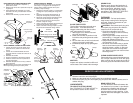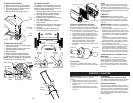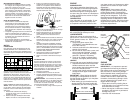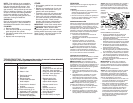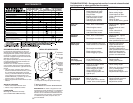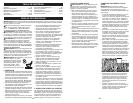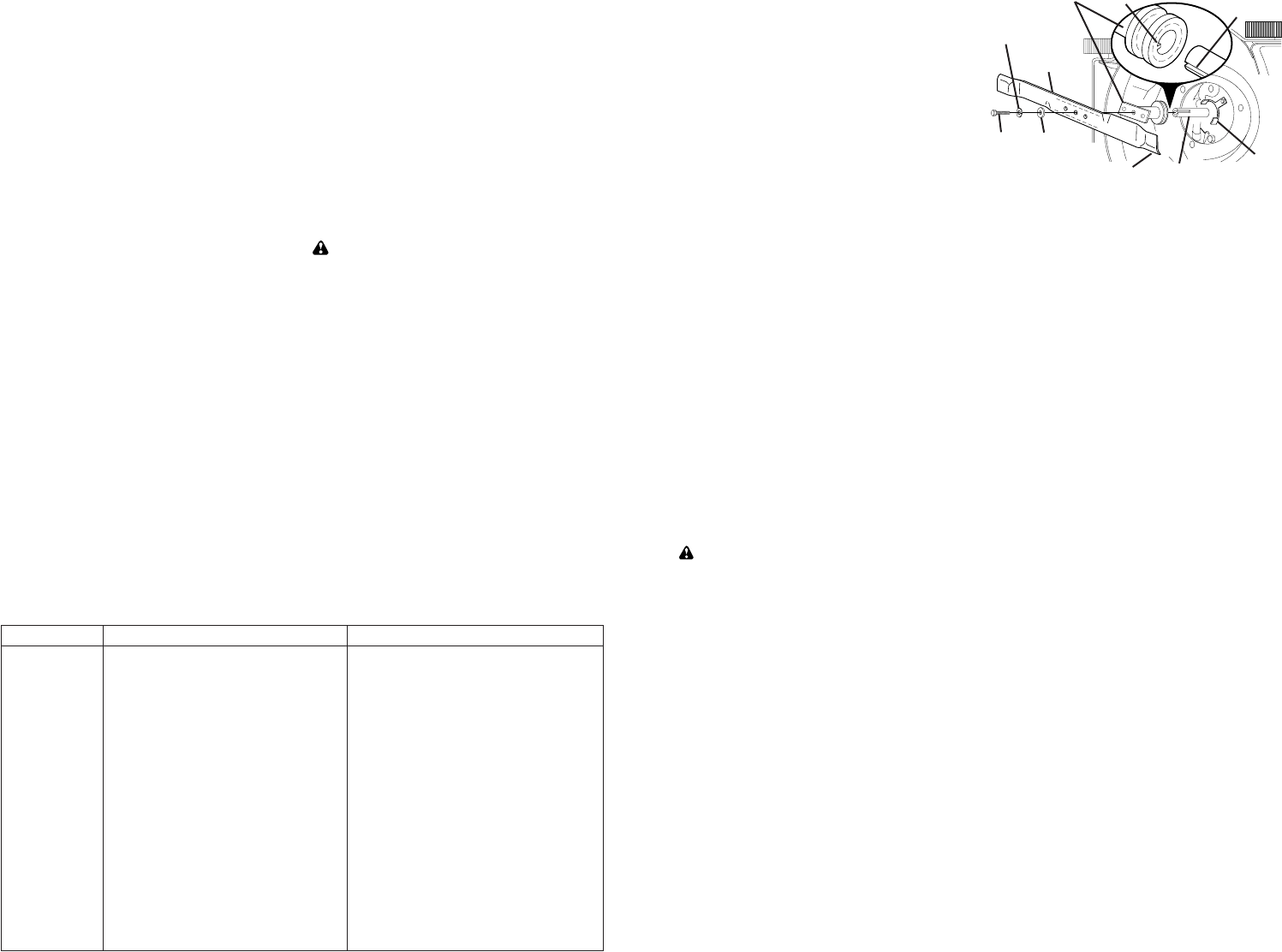
36
AVISO: El estabilizador de combustible es una
alternativa aceptable para reducir a un mínimo
la formación de depósitos de goma en el com-
bus ti ble durante el período de almacenamiento.
Agregue estabilizador a la gasolina en el
estanque de combustible o en el envase para el
almacenamiento. Siempre siga la proporción de
mezcla que se encuentra en el envase del esta-
bilizador. Haga funcionar el motor por lo menos
10 minutos después de agregar el estabilizador,
para permitir que este llegue al carburador. No
drene la gasolina del estanque de gasolina y el
carburador si se está usando estabilizador de
combustible.
ACEITE DEL MOTOR
Drene el aceite (con el motor caliente) y cám-
bielo con aceite de motor limpio. (Vea “MO-
TOR” en la sección de Mantenimento de este
manual.)
CILINDRO
1. Remueva la bujía.
2. Vacíe una onza (29 ml) de aceite a través
del agujero de la bujía en el cilindro.
3. Tire la manilla de arranque lentamente unas
cuantas veces para distribuir el aceite.
4. Vuelva a montar la nueva bujía.
OTROS
• No guarde la gasolina de una temporada a la
otra.
• Cambie el envase de la gasolina si se empie-
za a oxidar. La oxidación y/o la mugre en su
gasolina producirán problemas.
• Si es posible, guarde su unidad en un recinto
cerrado y cúbrala para protegerla contra el
polvo y la mugre.
• Cubra su unidad con un forro protector
adecuado que no retenga la humedad. No
use plástico. El plástico no puede respirar, lo
que permite la formación de condensación,
lo que producirá la oxidación de su unidad.
IMPORTANTE: Nunca cubra la segadora
mientras el motor y las areas de escape todavia
estan calientes.
PRECAUCIÓN: Nunca almacene la
segadora con gasolina en el estanque dentro
de un edifi cio en donde los gases pueden
alcanzar una llama expuesta o una chispa.
Permita que se enfríe el motor antes de
almacenarla en algún recinto cerrado.
No arranca 1. Filtro de aire sucio. 1. Limpie/cambie el fi ltro de aire.
2. Sin combustible. 2. Llene el estanque de combustible.
3. Combustible rancio. 3. Vaciar el estanque y vuelva a llenar-
lo con combustible limpio y nuevo.
4. Agua en el combustible. 4. Vaciar el estanque y vuelva a llenar-
lo con combustible limpio y nuevo.
5. Alambre de la bujía desconectado. 5. Conecte el alambre a la bujía.
6. Bujía mala. 6. Cambie la bujía.
7. Cuchilla suelta o adaptador 7. Apriete el perno de la cuchilla
de la cuchilla quebrado. cambie el adaptador de la cuchilla.
8. Barra de control en la 8. Presione la barra de control
posición suelta. hacia el mango.
9. Barra de control defectuosa. 9. Cambie la barra de control.
10. Válvula del combustible (si equ- 10. Gire a la válvula del combustible
ipada) está en la posición OFF. a la posición ON.
11. Batería débi (si equipada). 11. Cague la batería.
12. Desconecte el conector 12. Conecte la batería al motor.
de la batería (si equipada).
PROBLEMA CAUSA CORRECCIÓN
SOLUCIÓN DE PROBLEMAS - Vea la sección apropiada en el manual amenos que
esté dirigido a un centro de servico Husqvarna.
13
LAWN MOWER
Always observe safety rules when per-
form ing any main te nance.
TIRES
• Keep tires free of gasoline, oil, or insect
control chemi cals which can harm rubber.
• Avoid stumps, stones, deep ruts, sharp
objects and other hazards that may
cause tire damage.
DRIVE WHEELS
Check front drive wheels each time be fore
you mow to be sure they move freely.
The wheels not turning freely means trash,
grass cuttings, etc. are in the drive wheel
area and must be cleaned to free drive
wheels.
If necessary to clean the drive wheels, be
sure to clean both front wheels.
1. Remove hubcaps, locknuts & washers.
2. Remove wheels from wheel ad just ers.
3. Remove any trash or grass cuttings
from inside the dust cover, pinion and/
or drive wheel gear teeth.
4. Put wheels back in place.
NOTE: If after cleaning, the drive wheels
do not turn freely, contact a Husqvarna or
other qualifi ed service center.
BLADE CARE
For best results, blade must be kept
sharp. Re place a bent or dam aged blade.
CAUTION: Use only a replacement
blade approved by the manufacturer of
your mower. Using a blade not approved
by the manufacturer of your mower is haz-
ardous, could damage your mower and
void your warranty.
TO REMOVE BLADE
1. Disconnect spark plug wire from spark
plug and place wire where it cannot
come in contact with plug.
2. Turn lawn mower on its side. Make
sure air fi lter and carburetor are up.
3. Use a wood block between blade and
mower hous ing to prevent blade from
turning when re mov ing blade bolt.
NOTE: Protect your hands with gloves
and/or wrap blade with heavy cloth.
4. Remove blade bolt by turning counter-
clockwise.
5. Remove blade & attaching hard ware
(bolt, lock wash er & hardened wash er).
TO REPLACE BLADE
1. Position blade on the blade adapter
aligning the two (2) holes in the blade
with the raised lugs on the adapter.
2. Be sure the trailing edge of blade (op-
posite sharp edge) is up toward the
engine.
3. Install the blade bolt with the lock
washer and hardened washer into
blade adapter and crankshaft.
4. Use block of wood between blade and
lawn mower housing and tighten the
blade bolt, turning clockwise.
Recommended tightening torque: 35-40 ft. lbs.
IMPORTANT: Blade bolt is heat treated.
If bolt needs replacing, replace only with
approved bolt shown in the Repair Parts
section of this manual.
TO SHARPEN BLADE
NOTE: We do not recommend sharp-
en ing the blade - but if you do, be sure the
blade is balanced. Care should be taken
to keep the blade balanced. An un bal -
anced blade will cause eventual damage
to mower or engine.
• The blade can be sharp ened with a fi le
or on a grinding wheel. Do not attempt
to sharpen while on the mower.
• To check blade balance, drive a nail into
a beam or wall. Leave about one inch of
the straight nail ex posed. Place center
hole of blade over the head of the nail.
If blade is balanced, it should remain in
a horizontal position. If either end of the
blade moves downward, sharpen the
heavy end until the blade is balanced.
GRASS CATCHER
• The grass catcher may be hosed with
water, but must be dry when used.
• Check your grass catcher often for dam-
age or de te ri o ra tion. Through normal
use it will wear. If catcher needs replac-
ing, replace only with ap proved replace-
ment catcher shown in the Repair Parts
section of this manual. Give the lawn
mower model number when ordering.
Blade
bolt
Crankshaft
keyway
Hardened
washer
Lockwasher
Blade adapter Key
Blade
Trailing edge
Crankshaft
Belt
retainer



